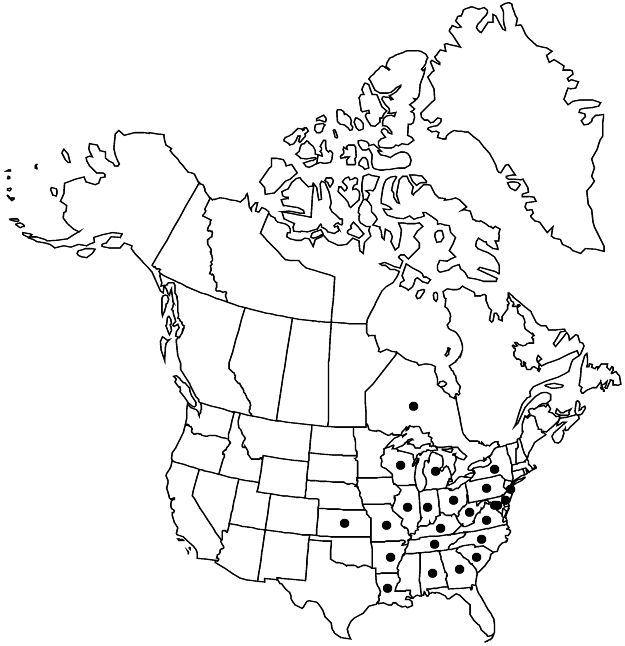Malus coronaria
Gard. Dict. ed. 8, Malus no. 2. 1768.
Trees, sometimes shrubs, 25–75 (–100) dm. Stems 1–45 cm diam.; bark reddish-brown to gray, longitudinally fissured with platelike scales; young branches reddish-brown to dark-brown, with orange lenticels, pubescent, glabrescent; flowering shoots becoming spurs or spiny thorns, (10–) 20–40 (–100) mm. Buds reddish-brown, ovoid, 1–6 mm, scale margins tomentose. Leaves conduplicate in bud; heteromorphic; stipules deciduous, linear-lanceolate, (3–) 4–6 (–7) mm, apex acuminate; vigorous shoot leaves: petiole (7–) 10–25 (–30) mm, glabrous or villous, sometimes puberulent; blade ovate or triangular-ovate, sometimes lanceolate, (2.5–) 4–8 (–10) × (1.5–) 4–6 (–8) cm, base rounded or cordate-rounded, sometimes cuneate, margins ± lobed, sometimes unlobed, serrate, sometimes doubly serrate or crenate-serrate, apex broadly acute or acute, sometimes rounded, apiculate, abaxial surface glabrous (villous only on veins), adaxial glabrous; flowering shoot leaves: petiole 5–15 (–25) mm, glabrous or villous; blade ovate, triangular-ovate, or lanceolate, sometimes oval or elliptic, (15–) 20–60 (–85) × (10–) 15–45 (–60) mm, base rounded or cordate, sometimes cuneate-rounded or cuneate, margins lobed or unlobed, serrate, sometimes crenate-serrate, doubly serrate, or entire, apex acute or broadly acute (rounded with point or rounded), abaxial surface glabrous (veins villous), adaxial glabrous. Panicles corymblike; peduncles absent; bracteoles sometimes persistent, filiform, 3–5 (–10) mm. Pedicels (10–) 20–30 (–40) mm, glabrous, sometimes villous. Flowers 25–40 mm diam.; hypanthium glabrous, sometimes puberulent; sepals triangular, (3–) 4–6 (–7) mm, equal to slightly longer than tube, apex acute or acuminate, abaxial surface glabrous, sometimes glabrescent, adaxial hoary-tomentose; petals pink, sometimes fading white, oblong-obovate, ovate, or oblong, (11–) 12–18 (–20) mm, claws (2–) 3–4 mm, margins entire, sinuate, or fimbriate, apex rounded; stamens 20, (8–) 10–13 (–14) mm, anthers pink, rose, salmon, or purple before dehiscence; styles 5, connate basally, (8–) 10–12 (–16) mm, equal to or slightly longer than stamens, villous in proximal 1/2. Pomes green or yellow-green, depressed-globose, 15–30 (–55) mm diam., cores not enclosed at apex; sepals persistent, erect; sclereids abundant surrounding core. Seeds dark-brown. 2n = 34, 51, 68.
Phenology: Flowering (Apr–)May(–Jun); fruiting Sep–Oct.
Habitat: Open woods, forest edges, thickets, stream banks, fields, fencerows, roadsides
Elevation: 50–1000 m
Distribution

Ont., Ala., Ark., Del., D.C., Ga., Ill., Ind., Kans., Ky., La., Md., Mich., Mo., N.J., N.Y., N.C., Ohio, Pa., S.C., Tenn., Va., W.Va., Wis.
Discussion
Leaves of Malus coronaria are variable in shape and lobing, leading Rehder in the early 1900s to recognize a number of eastern taxa. For examples, M. lancifolia was described as having ovate-lanceolate to oblong-lanceolate leaves; M. glabrata and M. glaucescens were described as having triangular-ovate or ovate leaves that are distinctly lobed. Specimens with relatively large fruit and only slightly lobed leaves were named M. platycarpa.
Double-flowered forms have been found in nature and selected for cultivation: forma charlottae Rehder and forma nieuwlandiana A. D. Slavin.
Selected References
None.
Lower Taxa
"dm" is not declared as a valid unit of measurement for this property.